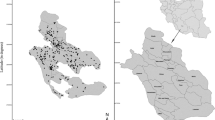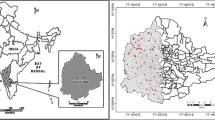Abstract
Multivariate statistical analysis and ArcGIS tools have been used to assess groundwater quality in the central part of Kuwait. The chemical data for groundwater samples collected from 71 bore wells are assessed to determine their suitability for drinking and irrigation purposes using the irrigation parameter indices. The WATEQ4F program is used to investigate the degree of saturation of groundwater with respect to the minerals calcite, dolomite, aragonite, halite, gypsum, magnesite, and brucite. In multivariate statistical analysis, principal component analysis (PCA) and R-mode and Q-mode cluster analysis are used to classify the groundwater into different clusters. In the PCA, the cumulative variance percentages of the first three components are 89.5%, expressed for four main chemical compounds, of which sodium chloride and sodium sulphate are the first principal component (PC1)compounds, with a variance of 65%, followed by the carbonates and silicates in PC2 and PC3, which are 15% and 9%, respectively. The Q-mode cluster mean value analysis identified four distinct groundwater chemical types, in which cluster I is mainly NaCl and SiO2, followed by Na2SO4 in cluster II, and the concentration of HCO3− revealed that clusters III and IV were mainly carbonate groups. In addition, the TDS and the TH clusters' mean values decrease from cluster I to cluster IV, indicating that the quality of the groundwater improves sequentially from cluster I to cluster IV. The results reveal that the groundwater in the study area is not suitable for drinking, but it is suitable for irrigation purposes.






Similar content being viewed by others
References
Al-Harbi A-R, Abdalrahman (2014) Statistical and analytical evolution of groundwater quality in Al-Raudhatain field. Environ Prog Sustain 33:895–904
Al-Ruwaih FM, Ben-Essa SA (2004) Hygrogeological and hydrochemical study of the Al-Shagaya field-F, Kuwait. Bull Eng Geol Environ 63:57–70
Al-Sulaimi JS, Al-Ruwaih FM (2005) Geology and natural resources of Kuwait. Academic Publication Council, Kuniv, 501
Ball JW, Nordstrom DK (1992) Geochemical model to calculate speciation of major, trace and redox elements in nature water. Report US Geological survey, Internal Groundwater Model Center, USA
Brown C (1998) Applied multivariate statistics in geo-hydrology and related science, 1st edn. Springer, Berlin, pp 1–248
Dalton MG, Upschurch SB (1978) Interpretation of hydrochemical facies by factor analysis. Groundwater 16:228–233
Doneen LD (1964) Notes on water quality in agriculture. In Davis, CA, water Science and Engineering, University of California
Drever JI (1997) The geochemistry of natural waters. Surface and groundwater environments, 3rd edn. Prentice Hall, Upper Saddle River
El-Nakhal HA, Ashour MM (1986) Water quality of the area west of Karak City. Jordan Qatar Univ Sci Bull 6:273–285
Fetter CW (2001) Applied hydrogeology. 4th ed, prentice hall, Upper Saddle River 2: 8
Freeze AR, Cherry JA (1979) Groundwater. Prentice Hall Inc, Englewood Cliffs. 7632: 604
Gibbs RT (1970) Mechanisms controlling world’s water chemistry. Science 170:1088–1090
Han YM, Du PX, Cao JJ, Posmentier ES (2006) Multivariate analysis of heavy metal contamination in urban dusts of Xi’an, Central China. Sci Total Environ 355:176–186
Helena B, Pardo R, Vega M, Barrado EL (2000) Temporal Fernandez evolution of groundwater composition in an alluvial aquifer (Pisuerga River, Spain) by principal component analysis. Water Res 34:807–816
Hem JD (1985) Study and interpretation of the chemical characteristics of natural water. USGS, Water Supply Paper 2254:264
Hem JD (1991) Study and interpretation of the chemical characteristics of natural waters, book 2254, 3rd edn. Jodhpur, Scientific Publishers
Hopke PK, Gladney ES, Gordon GE, Zoller WH, Jones AG (1976) The use of multivariate analysis to identify sources of selected elements in the Boston urban aerosol. Atmos Environ 10:1015–1025
Hussein MT (2004) Hydrochemical evaluation of groundwater in the Blue Nile Basin, eastern Sudan, using conventional and multivariate techniques. Hydrogeol J 12:144–158
Kaufman L (1990) Finding groups in data: an introduction to cluster analysis. Wiley, New York
Kelly WP (1951) Alkali soils their formation properties and reclamation, 3rd edn. Reinhold publication, New York, p 92
Li PY, Qian H, Wu JH, Zhang YQ, Zhang HB (2013) Major ion chemistry of shallow ground water in the Dongsheng coalfield, Ordos Basin, China. Mine Water Environ 32:195–206
Liu CW, Lin KH, Kuo YM (2003) Application of factor analysis in the assessment of ground water quality in a black foot disease area in Taiwan. Sci Total Environ 313:77–89
Mahlknecht J, Steinich B, Navarro de Leon I (2004) Groundwater chemistry and mass-transfers in the independence aquifer, Central Mexico, by using multivariate statistics and mass- balance models. Environ Geol 45:781–795
McKenna JE Jr (2003) An enhanced cluster analysis program with bootstrap significance testing for ecological community analysis. Environ Model Softw 18:205–220
Mendiguchia C, Moreno C, Galindo RMD, Garcia-Vargas M (2004) Using chemometric tools to assess anthropogenic effects in river water. A case study, Quadalquivir River (Spain). Anal Chem Acta 515:143–149
Omar SS, Al-Yaqubi A, Senay Y (1981) Stratigraphy of the Kuwait-Basrah area. In: Habitat of oil. AAPG Bull 22:1252–1278
Paliwal KV (1972) Irrigation with saline water. Monogram no.2 (new series). I A R I, New Delhi, p 198
Quddus KG, Zaman MW (1996) Irrigation water quality in some selected villages of Meherpur in Bangladesh. Bangladesh J Agril Sci 23:51–57
Rahman MS, Saha N, Molla AH (2014) Potential ecological risk assessment of heavy metal contamination in sediment and water body around Dhaka export processing zone, Bangladesh. Environ Earth Sci 71:2293–2308
Rapin F (1980) Anthropogenic effects on sediment from bay of Nice and Villefranche-Sur-Mer on the French coast. Ph.D. dissertation, University of Geneva, Geneva, Switzerland 221
Richards LA (1954) Diagnosis and improvement of saline and alkaline soils. US Department of Agriculture Hand Book: 60
Saether OM, de-Caritat P (1997) Geochemical processes, weathering and ground water recharge in catchments. Balkema, Rotterdam, the Netherlands, 400
Schoeller H (1977) Geochemistry of groundwater. In: Groundwater studies-an international guide for research and practice, vol 15. UNESCO, Paris, pp 1–18
Tang QY (2010) DPS Data Processing System, experimental design, statistical analysis and data mining, 2nd edn. Science Press, Beijing, p 1172
Taqveem AK, Abbasi AM (2013) Synthesis of parameters used to check the suitability of water for irrigation purposes. Int J Environ Sci 3:2031–2038
Todd DK, Mays LW (2005) Groundwater hydrology. John Wiley and sons, Inc 3rd: 636
Usunoff and Guzman (1989) A multivariate analysis in hydrochemistry. An example of the use of factor and correcpondence analyses. Groundwater 27:27–34
Voudouris K, Panagopolous A, Koumanatakis J (2000) Multivariate statistical analysis in the assessment of hydrochemistry of the northern Korinthia prefecture alluvial system (Peloponnese, Greece). Nat Res Forum 9:135–146
WHO (2008) Guidelines for drinking-water and quality incorporation, 3rd edn. WHO, Geneva, p 515
Wilcox LV (1955) Classification and use of irrigation waters. USDA Circular 969:19
Willet P (1987) Similarity and clustering in chemical information systems. Research Studies Press, Wiley, New York
Acknowledgements
The authors would like to thank the Ministry of Electricity and Water of Kuwait for providing the chemical analyses data for the study area.
Author information
Authors and Affiliations
Corresponding author
Rights and permissions
About this article
Cite this article
Shafiullah, G., Al-Ruwaih, F.M. Spatial-multivariate statistical analyses to assess water quality for irrigation of the central part of Kuwait. Bull Eng Geol Environ 79, 27–37 (2020). https://doi.org/10.1007/s10064-019-01559-2
Received:
Accepted:
Published:
Issue Date:
DOI: https://doi.org/10.1007/s10064-019-01559-2




